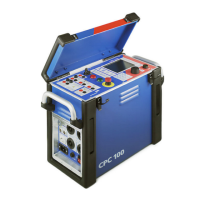CPC 100 V1.41
2 - 42
Creating Defaults and Templates
The CPC 100 software differentiates three types of templates:
1. test card default
2. test procedure default (default upon start-up)
3. test procedure templates.
Test Card Default
Rather than repeatedly filling out blank test cards with frequently used settings,
any test card with its actual settings can be made a test card default for that
particular type of card, for example, filling out a Quick test card with values and
pressing S
AVE AS DEFAULT makes this card the new Quick test card default.
Each card of this type, here Quick, that will later be inserted to a test procedure
will already hold these new settings.
In the CPC 100 file system, a test card default is not visible as a "file" (refer to
”The CPC 100 File System” in chapter 9).
Note: Pressing the R
ESTORE DEFAULTS menu key at the Options tab
Device Setup resets all user-specific settings made in the CPC 100
software to factory-defined defaults.
This includes the test card defaults and the test procedure default.
Note: The actual function of the context-dependent menu keys depends on
the selected view, test mode, test card and selected UI element.
To make the function S
AVE AS DEFAULT visible, the
focus (
⇒ Glossary) must be set onto the test card tab
designation, for example, ‘Quick’.
Note: A test card default contains user-defined settings, not test results.

